Did you know that being in nature can make kids more focused and creative? For new parents, gardening with a baby might seem tough, but it’s actually great for both of you. It’s a chance to bond with your child and make your garden beautiful.
Gardening lets your baby see the natural world safely and in a fun way. It teaches them about life, caring for things, and being responsible. Let’s learn some easy gardening tips that make it fun for us and our little ones. For more tips, check out this resource: how to garden with a baby.
Key Takeaways
- Gardening with infants can improve their sensory development.
- Introducing babies to gardening fosters curiosity and exploration.
- Simple activities like bubbles and water play are engaging and cost-effective.
- Encouraging hands-on experiences in the garden enhances skill development.
- Creating a safe outdoor play space from sustainable materials promotes creativity.
Why Gardening is Beneficial for Families
Gardening is great for families. It helps improve emotional health and brings families closer together. Working in the garden encourages talking and understanding among family members.
Studies show that kids who help grow and prepare food eat better. They learn to love fresh fruits and veggies. This can help them eat healthier for the rest of their lives.
Gardening is also good for kids’ physical health. It helps them use their muscles and can lower stress. It also makes them better at paying attention and remembering things.
Gardening helps with math and science too. Kids who garden do better on tests. For instance, growing plants teaches them about biology and the life cycle.
If you don’t have a big yard, you can still garden. Use containers or window boxes. Quick-growing plants like marigolds keep kids interested while they wait for bigger plants to grow.
Gardening teaches kids about responsibility and caring for the earth. They learn how to be good stewards of the land. These skills help them in many areas of life, not just gardening.
How to Garden with a Baby
Gardening with infants is both fun and challenging. It’s important to plan carefully and think about your baby’s needs. I aim to make the garden safe and fun for my little one while gardening.
Start by bringing your baby to the garden when they can sit, crawl, or pull up. This makes sure they’re ready for the outdoors. I suggest using a sturdy, lightweight playpen or a safe spot in the shade. This lets you watch your baby while you garden.
Try to garden in the early morning or late afternoon to avoid the heat. Using baby-safe sunscreen and insect repellent is key to protect your baby. These steps help keep your little one safe from the sun and bugs.
Getting older kids or pets involved can entertain your baby while you garden. They can play with your baby, letting you focus on your work. Working with family or friends to watch the baby can make gardening easier. Sometimes, hiring a babysitter for garden trips is a good idea too.
If you can’t get to a garden, try container gardening near your home. This way, you can garden with your baby close by. Making sure your garden is safe and fun is important for you and your baby.
| Gardening Tips | Considerations |
|---|---|
| Only garden when baby can sit/crawl | Ensure developmental readiness |
| Use a sturdy, lightweight playpen | Keep baby in a shady spot |
| Avoid midday heat | Prevent overexposure to sun |
| Apply baby-safe sunscreen | Protect delicate skin |
| Involve older children/pets | Keep baby entertained |
| Coordinate with family/friends | Take turns watching the baby |
| Consider container gardening | Easy access near home |
Creating a Safe Garden Space for Babies
Creating a safe garden for little ones is key. I’ve learned the value of planning and careful thought. It’s crucial to remove toxic plants and sharp tools to avoid risks. This makes the garden safe for babies.
Removing dangers is just the start. I also focus on adding shaded areas for rest. Umbrellas or tents are great for shade. They keep babies cool and safe from the sun.
Soft play zones are also a must. They let babies crawl and play safely. This keeps them away from dangers.
Adding sensory experiences keeps babies safe and engaged. Soft flowers and rough bark offer touch and exploration. A garden full of smells and colors makes it fun and safe for babies.
| Safety Measure | Purpose |
|---|---|
| Remove Toxic Plants | Prevent ingestion of harmful substances |
| Secure Tools and Sharp Objects | Eliminate risk of injuries |
| Install Shade Structures | Protect babies from sun exposure |
| Create Soft Play Zones | Provide safe areas for crawling and playing |
| Incorporate Sensory Elements | Encourage exploration while promoting safety |
Adding these steps to your garden plan makes it welcoming for parents and babies. A safe garden means peace of mind for caregivers. It also lets babies enjoy nature safely.
Essential Baby-Friendly Gardening Tools
Starting a gardening journey with your little one? Choosing the right gardening tools for parents is key. Baby-friendly gardening tools make the experience safer and more fun for your little ones. Here are some must-have tools for a happy gardening time:
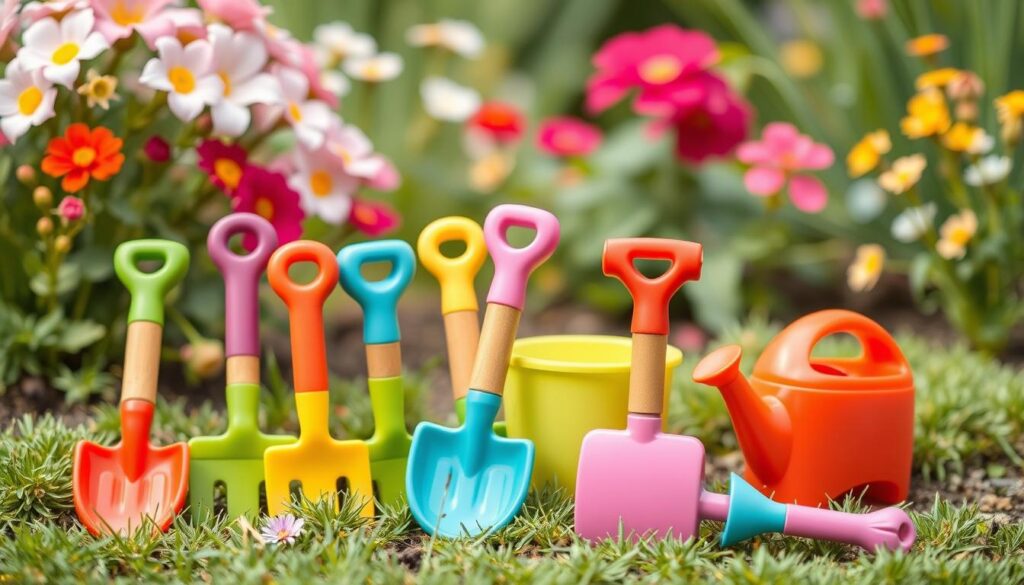
- Lightweight 5-gallon buckets: Great for carrying stuff or compost, they’re also good for small hands with 2-gallon options.
- Poly wheelbarrows: A six cubic feet wheelbarrow, especially one-wheeled ones, makes gardening easier for everyone.
- Short D-handle shovels: Kids can use 26” handles, and older kids prefer 46” handles.
- Various rakes and cultivators: Short-handle rakes and short 3-tine cultivators are great for getting the soil ready for planting.
- Radio Flyer Wagon: It’s perfect for moving things around, and the classic metal ones last a long time.
- Stirrup and hand hoes: These are great for older kids to weed quickly and well.
- Gardening gloves: Kids over 3 can wear these to keep their hands safe.
- Kid-sized wheelbarrows: Kids 4 and up can use these to play and learn on their own.
- Trowels and mini hoes: Perfect for kids 4 and 6, these tools help kids take care of plants.
Always use safe gardening equipment the right way. Keep sharp parts down and walk, don’t run, with your tools. This keeps everyone safe and teaches kids to be careful.
With the right baby-friendly gardening tools, gardening becomes a fun way to bond with your kids. It also helps them love nature more.
| Tool Type | Recommended Age | Purpose |
|---|---|---|
| Shovels | 3 years and up | Digging and planting |
| Rakes | 3 years and up | Soil preparation |
| Trowels | 4 years and up | Nurturing plants |
| Mini watering cans | 3 years and up | Watering plants |
| Kid-sized wheelbarrows | 4 years and up | Transporting supplies |
Engaging in Family Gardening Activities
Family gardening is a great way to spend time together and enjoy nature. It helps families work together and bond. Activities like planting flowers or a vegetable garden teach kids important skills and bring everyone closer.
Importance of Family Bonding Through Gardening
Gardening teaches kids important life skills like responsibility and patience. They learn as they help with different gardening tasks. It also helps with their fine motor skills and getting ready for harder tasks later.
It introduces kids to the life and food cycles, teaching them about sustainability. They get to explore nature with their senses, touching leaves, smelling herbs, and feeling the soil. These moments create strong family memories and a love for nature.
Setting up a garden shop for kids with small tables and tools makes learning fun. They practice skills like sorting and measuring while learning about gardening. Adding play elements makes gardening even more engaging and educational.
Letting kids do everything in the garden teaches them about growing plants. Games and activities keep them interested and learning. This makes gardening a fun and educational activity for the whole family.
Choosing Baby-Friendly Plants
As a parent, picking the right baby-friendly plants is key to a safe and lively space for my baby. Research shows that 8 out of 10 parents choose non-toxic plants for their baby’s room. This shows how important it is to pick safe plants for infants.
I look for plants that make the nursery look good and engage my baby’s senses. The Parlor Palm is a favorite, chosen by 6 out of 10 new parents for its easy care and playful vibe. It encourages my child to explore and learn.
The Pilea Peperomioides is also popular, with sales up 20% in a year. Its unique leaves and ability to spread out make it a hit in nurseries. The Ric Rac Cactus is also on the rise, with a 15% increase in online interest for its kid-friendly features.
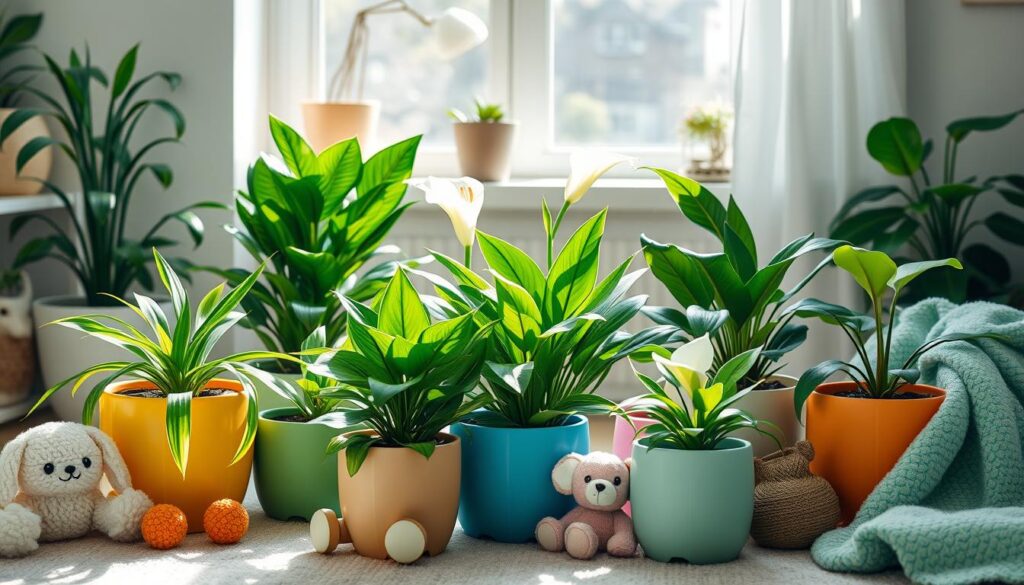
When searching for safe plants for infants, I look at edible flowers like nasturtiums and marigolds. They’re safe for kids and make the garden look great. Herbs like chives and lemon balm add a nice smell, making sensory experiences fun.
Sunflowers are great for fun growth challenges and teach my child about gardening. Cosmos and daisies attract bees and encourage nature interaction, deepening my child’s connection with the outdoors.
For those with little sunlight, faux plants are becoming more popular, with a 30% sales jump last quarter. These easy-care options let families enjoy plants without the hassle of real ones.
By picking baby-friendly plants wisely, my garden becomes a place where my child can safely discover colors, textures, and smells. For more tips on this, read this helpful article on choosing plants for families.
Outdoor Hobbies with Young Children
Exploring outdoor hobbies for young children brings joy and discovery for both kids and parents. Picnics, gardening, or nature walks are fun and help build a connection with nature. These activities are great for sparking curiosity and growth.
Being in nature is good for kids. Studies show that kids who spend time in green spaces are less likely to have mental health issues. It’s key to start healthy habits early. I love doing fun activities with my kids in nature. Here are some ideas:
- Painting rocks for our garden
- Making homemade playdough
- Going on a nature scavenger hunt
- Playing catch or throwing a frisbee
- Blowing bubbles with a DIY mix
These activities help kids connect with nature and stay active. The CDC says kids need 60 minutes of activity daily. These hobbies fit that bill and let families choose what they like.
| Activity | Type | Cost |
|---|---|---|
| Picnicking | Leisure | Free (homemade food) |
| Gardening | Creative | Variable (seed costs) |
| DIY Bird Feeders | Craft | Low (natural ingredients) |
| Outdoor Dance Party | Physical | Free (music) |
| Home Movie Filming | Creative | Free (using a smartphone) |
Adding these activities to our routine makes life more exciting. It’s a chance to make memories and enjoy fresh air. Outdoor hobbies for young children help grow skills, confidence, and family bonds, making every day an adventure.
Fun and Safe Garden Activities for Infants
Safe garden activities for infants spark their curiosity and boost their sensory experiences. I’ve found many fun and safe ways for my child to explore the garden. These activities make the garden a great place for learning and fun.
Bubble and Water Play
Bubbles are a hit with babies, offering them a visual treat. I use non-toxic bubble solutions for safety and fun. Simple bubble wands and containers are perfect for this.
Water play is also great for babies. A small, shallow tub filled with water lets them splash and feel the water’s texture. It’s a fun way to keep them safe and engaged.
Exploring Nature with Your Baby
Exploring nature with babies can spark their curiosity and love for the outdoors. I like setting up a blanket on the grass for tummy time. It lets my baby feel the grass and see the flowers.
Letting them see colorful flowers and hear nature’s sounds makes it even better. These moments turn into little adventures, helping them discover the world.
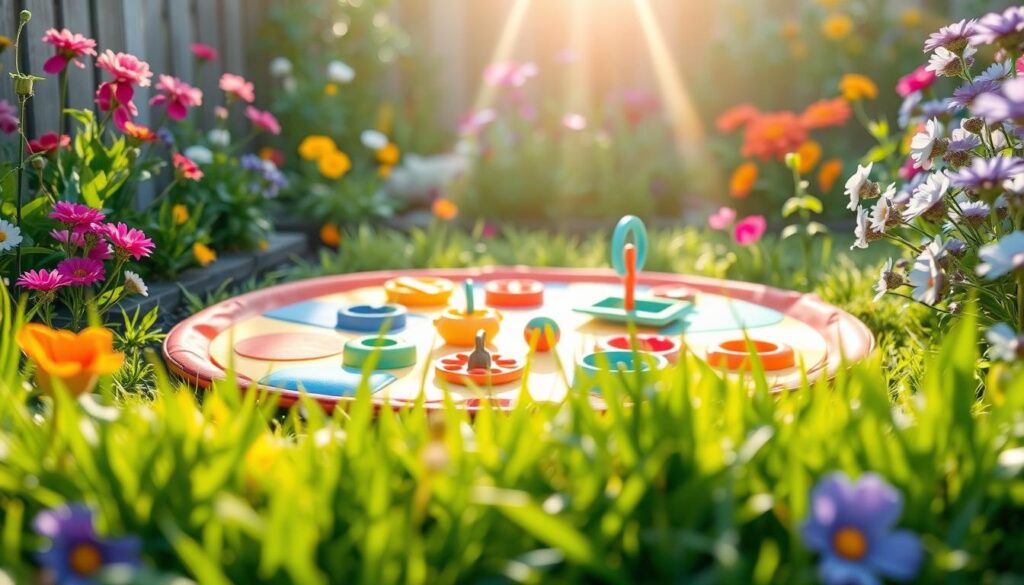
These safe activities help my child grow and connect with nature. They create special memories in the garden. These activities are practical and engaging, building a lifelong love for the outdoors.
Gardening Tips for New Parents
As a new parent, I’ve found ways to make gardening a part of our family life. It comes with its own set of challenges and joys. Here are my top tips for new parents, focusing on practical advice that helps my baby and the garden.
Planning is key. I set aside specific times for gardening that fit my baby’s schedule. This way, I can garden while watching my child, blending how to garden with a baby with parenting duties.
I create a special gardening area with raised beds for safety. It keeps my toddler away from sensitive plants but lets them explore. Fast-growing, kid-friendly plants like radishes and sunflowers are great for them to see the plant life cycle.
Getting my toddler involved in gardening teaches them responsibility and a love for nature. They help with digging, watering, and picking, which is great for them. Seeing the effort pay off makes them want to try the veggies we grow, which is a big part of my gardening tips for new parents.
Being adaptable is crucial in both parenting and gardening. Weather, my child’s mood, and daily life can change plans. Staying patient and flexible helps us enjoy gardening together as a family.
Introducing Babies to Nature
Bringing babies into nature is key for their early growth. Studies show that babies do well in places full of nature, using their senses and getting curious. Being in nature helps their brains grow, which is good for their development.
Babies who go outside often get many benefits. For example, being outside helps them relax and sleep better. A 2011 study found that nature makes babies talk more and helps them connect with others.
- Today, kids spend about four hours outside each week, much less than their parents did when they were young.
- Being in nature lowers anxiety and stress in kids, helping them feel emotionally strong.
- Nature also helps kids connect with where their food comes from, leading to better eating habits.
When I take my baby outside, I let them explore freely. This way, they learn about limits, safely check risks, and pick up important skills. Every time they’re outside, they learn more about the world. Exploring nature helps them appreciate the world and keeps them curious.
Conclusion
Gardening with a baby is more than making our gardens look nice. It helps teach important life skills and brings families closer together. From the start, kids learn about responsibility and nature. These early lessons lead to a love for gardening that lasts a lifetime.
Being in the garden together makes family time special. It helps us make memories that make our bond stronger. Kids learn about teamwork and curiosity by watering plants and making safe play areas.
Gardening is full of hands-on learning experiences. Kids get to touch soil and seeds and learn about plants. This not only teaches them but also makes them love eating healthy foods. I think gardening changes families for the better and sets a path to a healthier future.
For more on how gardening helps kids grow, check out this link.
FAQ
What are some safe gardening activities I can do with my baby?
Simple activities like planting seeds in small containers or using sensory play mats for tummy time are great. You can also set up a bubble play area. Always watch closely and make sure everything is safe for your baby.
How can I create a safe garden environment for my infant?
First, remove any toxic plants and secure sharp tools. Add shaded areas for your baby to explore. Soft play zones with blankets or mats are great for safe play while you garden.
What kinds of plants are baby-friendly for my garden?
Choose native, non-toxic plants that excite your baby’s senses. Fragrant herbs like basil or mint and bright flowers such as marigolds are good choices. Always check plant safety to make sure they’re okay for your baby.
How can gardening benefit my baby’s development?
Gardening provides many sensory experiences that boost cognitive development. Your baby will get to explore different colors, textures, and smells. This helps them learn and grow.
What are some practical tips for gardening with an infant?
Use baby carriers or gentle swings to keep your baby close while gardening. Schedule short gardening times that fit with your baby’s nap schedule. Choose tasks that you can easily pause if needed.
Are there outdoor hobbies that I can enjoy with my baby besides gardening?
Yes! You can go on nature walks, have picnics in the park, or do simple outdoor crafts. These activities help you connect with nature and are good for your baby’s development.
How can I involve my baby in gardening activities?
Let your baby explore the garden’s textures, colors, and sounds. They can do tummy time on the grass or watch plants safely. Touching leaves or flowers under your watchful eye can be a fun learning experience.
What tools should I consider using for baby-friendly gardening?
Choose lightweight hand tools, ergonomic gloves, and strong containers. These will be easy for you to handle while watching your baby. Make sure all tools are childproof and stored safely when not in use.

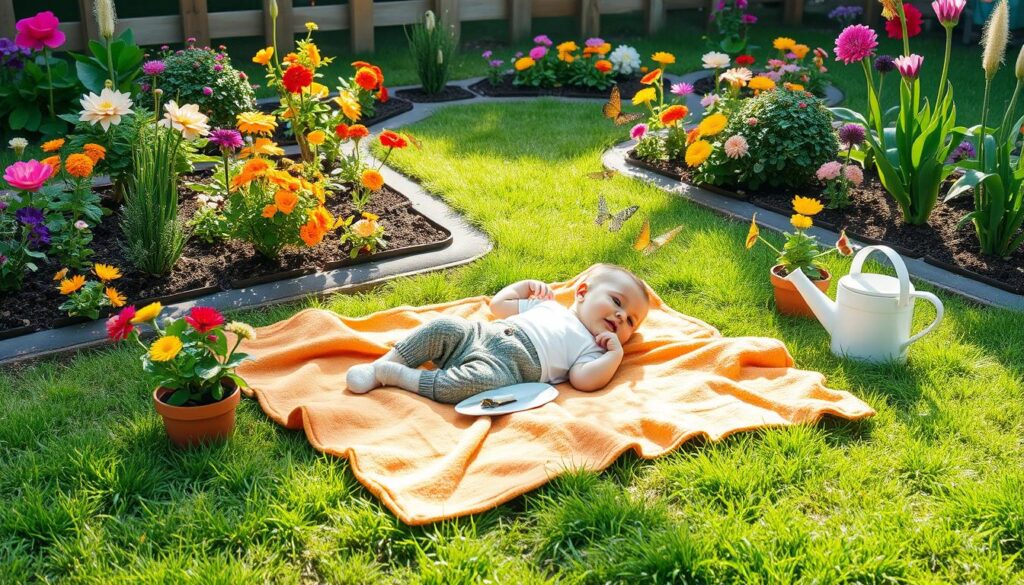

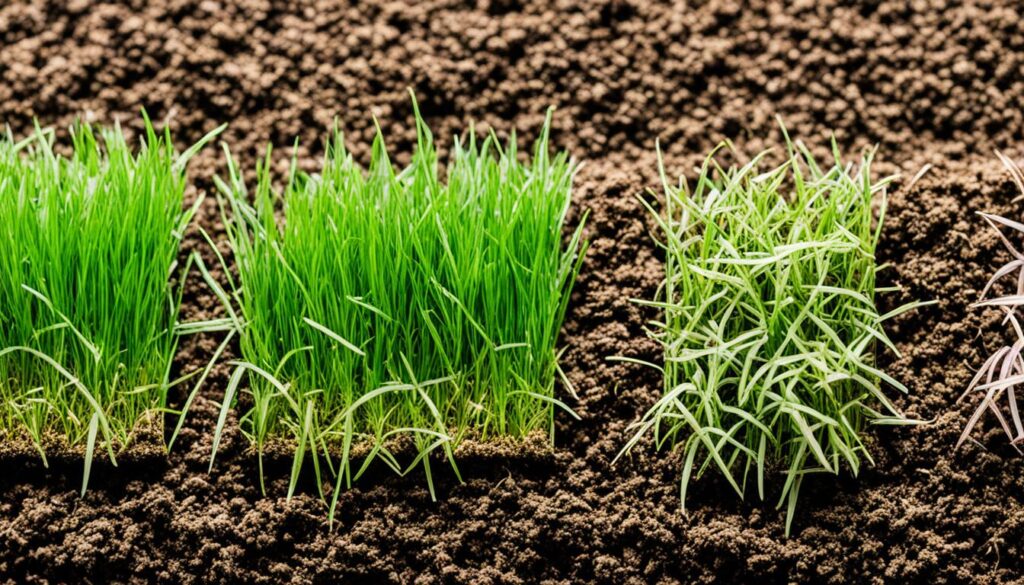
Thank you for this fantastic post! The information you provided is very useful and well-explained. I especially liked how you broke down complex concepts into easily understandable parts. Your writing is clear and concise, making it a pleasure to read. Looking forward to more of your posts.
Hello! I wanted to drop by and say that I really enjoyed this blog post. Your writing is always so clear and concise, and you have a talent for making complex topics easy to understand. Thank you for sharing your insights with us. I’m looking forward to your next post!
Hi there! I must say, this blog post really caught my attention. Your writing style is so captivating, and the way you presented the information made it easy to understand and enjoyable to read. Thank you for sharing your expertise on this topic. I’m eager to see what you write about next.
Hey there! Just wanted to say how much I enjoyed reading this post. Your approach to the subject was unique and informative. It’s clear that you put a lot of effort into your writing. Keep up the great work, and I can’t wait to see what else you have in store.
Hello! I wanted to drop by and say that I really enjoyed this blog post. Your writing is always so clear and concise, and you have a talent for making complex topics easy to understand. Thank you for sharing your insights with us. I’m looking forward to your next post!
Hey there! I wanted to take a moment to let you know how much I enjoyed this blog post. Your insights were incredibly helpful and thought-provoking. It’s clear that you put a lot of effort into your writing. Thank you for sharing your expertise with us. Looking forward to your next post!
Hi there! Just wanted to let you know how much I enjoyed reading this post. Your approach to the subject was unique and informative. It’s clear that you put a lot of effort into your writing. Keep up the great work, and I can’t wait to see what else you have in store.
Hi! I just finished reading your blog post, and I must say, it was excellent. Your ability to explain complicated concepts in a simple and engaging way is truly remarkable. Thank you for providing such valuable content. I can’t wait to read more from you in the future.
Hello! I wanted to drop by and say that I really enjoyed this blog post. Your writing is always so clear and concise, and you have a talent for making complex topics easy to understand. Thank you for sharing your insights with us. I’m looking forward to your next post!
Thank you for this fantastic post! The information you provided is very useful and well-explained. I especially liked how you broke down complex concepts into easily understandable parts. Your writing is clear and concise, making it a pleasure to read. Looking forward to more of your posts.